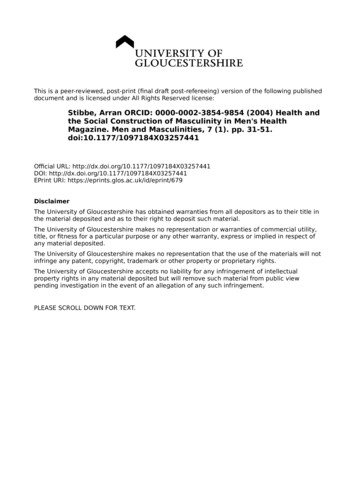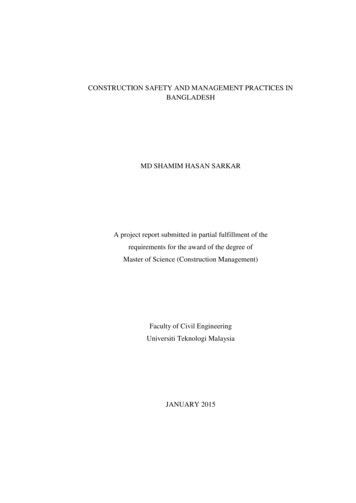
Transcription
This is a peer-reviewed, post-print (final draft post-refereeing) version of the following publisheddocument and is licensed under All Rights Reserved license:Stibbe, Arran ORCID: 0000-0002-3854-9854 (2004) Health andthe Social Construction of Masculinity in Men's HealthMagazine. Men and Masculinities, 7 (1). pp. 31-51.doi:10.1177/1097184X03257441Official URL: http://dx.doi.org/10.1177/1097184X03257441DOI: http://dx.doi.org/10.1177/1097184X03257441EPrint URI: The University of Gloucestershire has obtained warranties from all depositors as to their title inthe material deposited and as to their right to deposit such material.The University of Gloucestershire makes no representation or warranties of commercial utility,title, or fitness for a particular purpose or any other warranty, express or implied in respect ofany material deposited.The University of Gloucestershire makes no representation that the use of the materials will notinfringe any patent, copyright, trademark or other property or proprietary rights.The University of Gloucestershire accepts no liability for any infringement of intellectualproperty rights in any material deposited but will remove such material from public viewpending investigation in the event of an allegation of any such infringement.PLEASE SCROLL DOWN FOR TEXT.
Health and the social construction of masculinity in Men’s Healthmagazine.Arran StibbeAbstractAlthough health has not traditionally been a male concern, the last few years have seen the ‘gradualdevelopment of a shared, public concept of men’s health’ (Courtenay and Keeling 2000:243). Among theleading participants in the construction of this concept is Men’s Health magazine. In this paper, a sample ofsix issues of Men’s Health (June – December 2000) are critically analyzed in order to reveal the ideologicalassumptions on which the discourse of the magazine is based. Evidence is presented which suggests thatMen’s Health magazine, while giving abundant health advice, does so in a way which reproduces a type ofhegemonic masculinity associated not with health, but with a variety of negative health behaviors.Keywords: men’s health, critical discourse analysis, social construction, masculinity, magazinesIntroductionMen, it seems, are doing something wrong. For most of this century male life expectancy has beenconsistently lower for men than for women (Furber 1999:91). Males have ‘higher mortality than females fortotal mortality and for most causes of death in contemporary developed countries’ (Waldron 2000:150). In theUS, ‘men die more than six years younger than women’ (Courtenay 2000a:81). Men’s excess mortality cannotbe attributed to biological factors alone, leaving at least part of the blame on ‘psychological, social andbehavioral factors’ (Helgeson 1995:62), that is, what men are doing.Courtenay’s (2000a) report on ‘Behavioral factors associated with disease, injury and death amongmen’ lists over 30 behaviors in which men have greater involvement than women, and which are known tolead to health problems, including smoking, bad diet, excess alcohol consumption, and risk taking. However,as Courtenay points out in the conclusion of his report, very little ‘is known about the psychosocialmechanisms that mediate these behaviors’ (ibid.:109).Helgeson (1995:68) claims that ‘a sizeable portion of men’s excess mortality is linked to masculineidentity, men’s roles, and gendered patterns of socialization’. The construction of gender within societycreates differing patterns of expectation for men and women, which in turn lead to different behavior andhealth risks. According to Berger et al (1995:2), gender is articulated ‘through a variety of positions,languages, institutions and apparatuses’, and constructed from ‘a complex web of influences’. When it comesto health behavior, influences may include books, films, images on television, the advice of doctors, thecomments or teasing of friends, and quite recently for men, magazines.In December 2000, a magazine with a cover picture of a huge, muscular, male torso and the bold redletters ‘Build This Body!’ was on the newsstands. Men’s Health magazine has a circulation of approximately1,650,000 in the US and more than twice that number internationally. It is providing for men what womenhave had for a very long time: a lifestyle magazine which gives advice on every aspect of living from sex toshoes, and, incidentally, health.While there is a large amount of feminist literature on the construction of femininity in women’smagazines, the corresponding literature on men’s magazines is limited, and tends to focus on the constructionof the male consumer (e.g., Greenfield et al 1999, Breazeale 1994). The feminist analysis can, however, beextended to men’s magazines, and particularly health magazines.Courtenay suggests that there is a link between male power, the construction of masculinity, andunhealthy behavior:By successfully using unhealthy beliefs and behaviors to demonstrate idealized forms ofmasculinity, men are able to assume positions of power – relative to women and less powerfulmen – in a patriarchal society that rewards this accomplishment. (Courtenay 2000b:1397)The idea that men act in ways that damage their health in order to gain power and privilege hasprofound implications both for gender equality and health promotion. This paper focuses on the role thatMen’s Health magazine plays in the mediation of masculinity and health behavior.Masculinity and male power1
True masculinity, according to Connell (1995,45) is ‘almost always thought to proceed from men’sbodies’. It is therefore intimately linked with health, providing ‘the focal point of self-construction as well ashealth construction’ (Saltonstall 1993:12).However, ‘masculinity’ is, as Berger et al (1995:2) describe, a ‘vexed term, variously inflected,multiply defined, not limited to straight forward descriptions of maleness.’ (Berger et al:2). What is certain isthat ‘nothing like one-way determination of the social by the biological can be sustained’ (Connell 1995:47).Biological determinism, which sees gender differences as biologically based, and therefore natural, inevitableand unchangeable, is an ideological position used to justify and perpetuate male power. In challenging thisposition, masculinity is often taken to the opposite extreme, and treated as a wholly socially constructedphenomenon, for example:Masculinity is a concept that bears only an adventitious relation to biological sex and whosevarious manifestations collectively constitute the cultural, social, and psychosexual expressionof gender (Solomon-Godeau 1995:71)But, as Brittan (1989:14) points out, ‘men and women do not exist outside their bodies’, and this approachmisses the role that bodies play within human interaction and society. In Connell’s (1995) approach, ‘bodiesare seen as sharing in social agency, in generating and shaping courses of social conduct’ (Connell 1995:54).The biological may not determine the social, but that does not stop men from ‘artificially attachingall manner of power and privilege to biological differences’ (Klein 1993:5) in order to gain power overwomen. For example, men’s ‘greater sporting prowess’, which is related to biological factors, is given socialsignificance and becomes ‘symbolic proof of men’s superiority’ (Connell 1995:54).However multiple and contested the concept may be, there is one form of masculinity which appearsrepeatedly in the literature, albeit with different names and slightly different definitions. The names include‘hegemonic’ masculinity (Connell 1995), ‘traditional’ masculinity (Helgeson 1995), ‘dominant’ masculinity(Courtenay 2000b), and ‘negative or extreme’ masculinity (Helgeson 1995). While styles of masculinitychange, what does not so easily change is the ‘justification and naturalization of male power’ (Brittan 1989:2).Hegemonic masculinity, as an ‘expression of the privilege men collectively have over women’ (Connell1996:209), is therefore the least likely to change, particularly in those aspects which exploit biological factors.It is this form of masculinity which leads to the negative health behaviors described by Courtenay (2000a),and is most in need of challenging by publications related to men’s health.Hegemonic masculinity and discourseHegemony is power which ‘makes people act as if it were natural, normal, or simply a consensus’(van Dijk 1997:19). In the case of masculinity, ‘traditional characteristics of masculinity are made to seem socorrect and natural that men find domination not just expected, but actually demanded.’ (Craig 1992:3).Hegemonic masculinity is reproduced through discourses which make it seem natural, inevitable, andmorally right that men behave in particular ways: Bhabha (1995:57) was asked ‘Are you a man or a mouse?’by his father, a question which presupposes bravery to be a natural feature of masculinity. But hegemonicdiscourses both can be, and are, challenged through counter discourses such as the discourse of feminism.Following the general linguistic turn in the humanities, the study of gender is moving towards theanalysis of the ‘construction of a range of masculinities and femininities through a range of gendereddiscourse in a range of topically-related texts’ (Sunderland 2000:250). This approach to gender assumes adialectic relationship between social practice and discourse, where discourse is both ‘shaped and constrainedby social structure’ as well as ‘socially constitutive’ (Fairclough 1992:64).Counter discourse offers a means to challenge some of the aspects of hegemonic masculinity thatlead to negative health behavior. However, this paper will argue that Men’s Health magazine is steeped intraditional masculine ideology, and fails to challenge the discourse of hegemonic masculinity in the interest ofhealth.Masculinist ideology in Men’s Health magazineHegemonic masculinity is ‘embodied in heterosexual, highly educated, European American men ofupper-class economic status’ (Courtenay 2000b:1388). To its commercial advantage, Men’s Health magazineis aimed at exactly this group. The South African edition expresses this metaphorically as:[Men’s Health] provides focused penetration directly at the affluent, male market, deliveringsophisticated, upscale males to discerning advertisers. (South Africa 2000)2
Brittan (1989:5) has problems with analyses which assume men have a ‘collective ideology’, since men donot constitute a class. However, the men targeted by Men’s Health do form a class, and it is the class withmost to gain from the reproduction of male domination. The intended readership can be seen in quotes such asthe following, which describes the situation of being pulled over by a cop 1: Here’s how his [the cop’s] life stacks up against yours: He doesn’t have your MBA, he’s not holding yourstock options, and he’s not next in line for that CEO slot. (Men’s Health, US edition, September2000:128)The magazine itself is politically conservative, encouraging voters to ‘Vote for someone who will cuttaxes’ (October 2000:94), and frequently questioning the masculinity of Al Gore ‘who ‘will never be cool’unless he lives ‘to be 100 and die[s] in bed surrounded by naked nurses’ (October:97), and the Democraticparty ‘In case you don’t know which way to vote: Democrats are more likely than Republicans to own a cat.’(September:50). The ideology of the magazine is reflected in many of the items listed in the article ‘138things a man should never apologize for’, some of which appear below (September:90): As decent, honorable men, we should never apologize for Liking McDonaldsNot offering a vegetarian alternativeWearing fur or leatherLaughing at people who eat trail mixReading pornography regularlyOrdering the vealCalling women girlsPutting your feet up on something like say, your wifeliking gunsholding a door open for a woman (September:90)Rutherford (1998:4) describes the way that ‘in the post-feminist era of the 1990s, there has been growingdisaffection amongst middle class men with the ideal of sexual equality’. This is reflected in the list above, aswell as disaffection with other groups that challenge domination such as animal rights activists and guncontrol lobbyists. The anti-feminist stance is revealed in an article about choosing a university for your son.The questions to ask are ‘Do campus officials parrot the feminist myths? How cranky is the women’s studiesdepartment? Exactly what is the sexual-harassment policy?’ (September:122). The ideal school is one where‘the traditional male view is appreciated’ (September:121).As well as health, Men’s Health appears to have a masculinist agenda of power: ‘Why We Wear thePants: Everything we write about is for one purpose – we want to help men control their lives’(September:26). This is not just power over women, but power over other men too: ‘Anger is avirtue without a temper.your boss will continually step on your face’ (November:58), ‘When you have it infor a guy, don’t have it in halfway. Make the blade come out through his spine.’ (June:54).Men’s Health is therefore in an anomalous position. It is written for the men who are most exposedto, and have most to gain from, the ideals of hegemonic masculinity, and has an openly admitted agenda ofpromoting ‘the traditional male view’. On the other hand, traditional masculinity has been shown to involve alarge number of negative health behaviors such as excessive alcohol consumption and risky behavior.As Courtenay (2000a) points out, health is traditionally a female rather than male concern. Lifestylemagazines too, with a few exceptions such as Esquire and GQ, are almost exclusively aimed at women. Men’sHealth is therefore forging a new kind of discourse, which goes beyond the dry, scientific discourse of bookslike Brewer’s (1995) A Complete Guide to Men’s Health, and beyond what Haines (1998) calls the ‘soulwithering monotony of weight training instruction’.To provide an analysis of this emergent discourse and the ideological assumptions on which it isbased, six issues of the US edition of Men’s Health (June 2000-December 2000), were analyzed in detailwithin a critical discourse analysis (CDA) framework (Fairclough 1992, 1989, Fowler 1991, van Dijk 1997,1993). CDA provides ‘an account of the role of language, language use, discourse or communicative events inthe (re)production of dominance ’ (van Dijk 1993:282). It involves the analysis of linguistic features such asvocabulary, grammar, textual structures, and punctuation, in order to reveal hidden ideological assumptionson which discourse is based (Fairclough’s 1992, 1989).The analysis focuses on the interaction of three aspects: a) The discursive construction of masculinityin the magazine through the creation of images of the ideal man, b) the magazine’s role in reproducing male3
power, and c) men’s health behavior, particularly the negative health behaviors associated with hegemonicmasculinity listed by Courtenay (2000a).Analysis and discussionAlthough there are many different writers in Men’s Health, there are two main discourses whichintertwine throughout the magazine: the discourse of medical science and the discourse of the ‘buddy’. This‘buddy’ is a deliberate creation of the magazine: ‘We are like a buddy not some pompous know-it-all.’(Men’s Health editor, Stump 1999). The ‘buddy’ acts as an intermediary, explaining and interpreting medicalscience for the reader. The following extract reveals the meshing together of the two discourses: A preliminary study from the Rowett Research Institute found that a compound P3 in the yellow gooparound tomato seeds reduced platelet clumping by 72 percent. Lower platelet aggregation reduces the riskof blood clots [next section] if your blood tests show elevated levels of homocysteine, substitute acold frosty one for the Merlot. Scientists gave a group of men wine, beer, gin, or water with dinner.The wine and gin raised homocysteine levels a bit; the beer didn’t. (November:26)In this extract, terms such as ‘platelet aggregation’ and ‘homocysteine levels’ from authoritative medicaldiscourse are used, but associated with scientists or researchers. At the same time, this discourse is mixed withinformal terms such as ‘yellow goop’ and ‘a cold frosty one’, reminding the reader that it is the buddyspeaking, not the scientists. The buddy also interprets the science and draws conclusions in the familiar voiceof the life-world: the contents page reduces the above extract to ‘Why you need more pizza and beer’(November).Given men’s lack of health-care utilization (Courtenay 2000b:83), and unwillingness to see a doctor(‘I don’t go to the doctor unless something scares the hell out of me.’ Men’s Health editorial, June:16), thevoice of the buddy plays an important role in terms of power relations. If men take the advice of a friend, theyare not capitulating to a more powerful expert, the ‘pompous know-it-all’. At the same time, the buddy claimsthe backing and support of the full force of medical authority in the form of scientists and researchers.This powerful discursive device is used to offer advice to readers to help them fulfill their healthgoals and other desires. However, the reader’s desires are partially constructed by the magazine itself throughimages of the ideal man: the ‘definitive cultural icon of masculinity’ in the words of Men’s Health fitnesseditor, Lou Schuler (in Trebay 2000).The ideals the magazine sets up for its readers to aim for can be seen in short imperative statementswhich follow the pattern of ‘Win a cruise for two!’ Imperatives such as these always contain a desirable goal,so placing any goal in this grammatical construction presupposes its desirability. Some of these goals, like‘Never have a heart attack’ (June, cover) are straight, unproblematic health goals. Others, however, seem toinvolve an agenda which goes beyond health. The following sections highlight several aspects of the idealman constructed by the magazine which appear to go beyond simple health considerations.The ideal man: A bodybuilderThe primary goal the magazine establishes through imperatives is increasing muscle size: ADD 2 inches to your chest (October, cover)BUILD ABS THAT SHOW. (July/August, cover)Build this body! [arrow points to a huge muscular torso, expanded so large that most of the head andright shoulder cannot be seen] (December, cover)Look like a Men’s Health cover model. [with picture of 4 muscular men] (December:110)Isolated noun phrases are used in the same way: More Muscle, Faster. (July/August:25)SOLID MUSCLE! (November, cover)Bigger Muscles! (December, contents)Big biceps in 3 minutes (October, contents)This orchestration of the desire for big muscles both reflects reality (Jacobi and Cash 1994 report that 91%percent of men want to be more muscular) and contributes to the construction and reproduction of the desire.The ideal shape is reflected by the ‘cover models’, a group of identically shaped men: hugely muscular, lean,tanned, body hair shaved:4
What does it take to look like a Men’s Health cover model? Our top guys share their secrets, and showyou how to get the look you want. (December, contents, emphasis added)The noun phrase ‘the look you want’ presupposes ‘you want to look’ like the cover models. This gives nooption for the reader to choose an ideal shape, perhaps a well-toned athletic body, from a number ofalternatives. Even the article which shows a range of bodybuilders of different sizes is entitled ‘How BIG canyou get? Here’s what it takes to move up in the world’ (October:104 red emphasis in original). Thesebodybuilders weigh up to 225 pounds, with huge torsos, arms, and necks, but, in order to model trousers,surprisingly thin legs. The cosmetic nature of the muscularity is clear from comments such as, for onebodybuilder: ‘he doesn’t do any lifting with his legs’ (October 104), for another ‘he doesn’t do any resistanceexercise for his legs’ (October:105). One Men’s Health model, who ‘marvels at how little exercise it takes tokeep his body camera ready’, ‘does no cardiovascular exercise beyond a 5-minute warmup’ (December 115).The only way to achieve muscles like the cover models of Men’s Health is to enter the world ofbodybuilding, which Klein (1993:3) calls the ‘subculture of hyperbole’. In Men’s Health, hyperbole takes theform of simile: ARMS! Like Anacondas (That Just Ate a Pig) (September, cover)arms that bulge like VW beetles (October:45)arms that have more bulges than a plastic surgeon’s mistress (November:32)abs like speed bumps (July/August:115)While doing anaerobic exercise and having adequate muscle mass and tone is clearly an importanthealth goal, selectively developing huge muscles is not. Indeed, Thompson (1999) describes how ideals ofmuscularity can lead to steroid use, negative body image, eating disorders, and the recently occurring ‘muscledysmorphia’ disorder in bodybuilders.Bodybuilding, however, represents ‘the most extreme view of masculinity our society has’ (Klein1993:18). If men compete with each other for power according to muscle size, men as a group win overwomen. Because ‘bodybuilding fetishizes muscles, it further exaggerates gender-based characteristics thatare loaded with cultural meaning’ Klein (1992:106). The construction of the ideal man as hugely musculartherefore serves the ideological goal of reproducing male power.It may also serve commercial goals. Most readers do not look like cover models, and without a hugeamount of effort never will. This has the potential to create anxiety which keeps readers buying the magazinefor the promise of short cuts to the far off goal.The ideal man: A meat eaterWhile ‘ADD 2 inches to your chest’ could be considered a goal which is tangential to health ingeneral, an imperative statement in the December issue ‘Unleash your inner carnivore’ (next to a picture of ableeding steak) appears to encourage behavior which could actually damage health. The associated eight page‘Special Carnivore Section’ is titled: Men and meat: There’s only one kind of flesh we like better and even then she’d better know how to grill.(December:165-172).According to Courtenay (2000a:90), ‘the average man’s diet is a major contributor to heart diseaseand cancer’, particularly in lack of fiber, fruit and vegetables, and excess cholesterol, which ‘the bodyproduces after consuming animal fat’. He reports that ‘males of all ages consume more saturated fat anddietary cholesterol than females [and] are less likely to limit fat or red meat in their diet’. Red meat isalso ‘the food with the strongest positive link to advanced prostate cancer’ (Brewer 1995:122). In her‘Complete guide to Men’s Health’, Brewer gives the direct advice ‘Cut out red meat – or only eat itoccasionally.’ (ibid.:122) and ‘have more vegetarian meals instead’ (ibid.:199).Men’s Health magazine, on the other hand, while sometimes promoting the health properties ofspecific vegetables, never, in the sample analyzed, suggests a reduction in meat. Even in articles dealing withheart disease, cancer, diabetes or hemorrhoids, the magazine fails to link red meat with disease or any othernegative consequences. Instead, meat, and particularly beef, is consistently associated with positive images ofmasculinity. The primary connection is via muscle: meat has big advantages over all other foods: It packs muscle-building protein (December:166)Meat is loaded with the protein needed to build new muscle (December:166)5
The muscle stoker [recipe] eat this meal and you’ll grow your biceps That’s because the protein in thebeef [1lb top London broil] helps to build new muscle tissue (July/August 87)make your meat beef and you’ll also get testosterone-boosting amino acids. Testosterone helps you liftmore weight and build more muscle. (November, p84)These all specifically link eating meat to getting larger muscles, the primary target set up by the magazine forits readers. Beef is taken as a synonym for protein, quite literally in the following extract: I bought a steer an impulse protein buy. Skippy [the steer] was about to metamorphose into the bestform of nourishment, namely, comestible protein. (December:170)Brewer (1995:333), however, gives completely different advice: ‘It is important not to eat too muchprotein Try to obtain dietary protein from eating fish, white meat, wholegrains, nuts, seeds and beans ratherthan eating a lot of red meat’.In addition to emphasizing the muscle building properties of meat, the magazine constructs amasculine image of meat. The article ‘Your dinner personality’ (September:49) consists of a series of picturesof food with a single, unattributed quote next to each, defining the associated personality. These quotes arederived in an unspecified way from a poll of 220 women, asked to say ‘which meals impress them’.Predictably the beef has masculine attributes. The T-bone steak is ‘Something a big man would eat’, and has apicture of John Wayne, who Adams (1990:38) calls the ‘epitome of the masculine meat eater’. The FiletMignon says ‘Classy, likes to indulge’, and even the burger says ‘The guy can be himself’. Chicken with rice,on the other hand, is ‘too healthy’, and the only vegetable dish, piled high with steamed vegetables (PastaPrimavera), is ‘Dull choice, dull guy’. This imagery replaces the voice of doctors such as Brewer (1995) whosay ‘cut out red meat’, with the voices of 220 woman who say ‘order meat to impress me’.Vegetables are not only portrayed as dull, but also as effeminate: Vegetables are for girls If your instincts tell you a vegetarian diet isn’t manly, you’re right. One Britishstudy found that vegetarian women give birth to girls more often than meat eating women. (December66).This humor, like much of the humor in the magazine, is loaded with gender ideology. Anotherinstance of this is: Your body needs dietary fat to produce testosterone, so eating like a vegetarian aerobics instructor willcause your testosterone levels to sink drastically. That is bad, unless you actually are a vegetarianaerobics instructor (December:106).The word ‘vegetarian’ is inserted here gratuitously (the same article says that it is monounsaturatedfat from vegetable sources which boosts testosterone). It does, however, achieve a link betweenvegetarianism, aerobics (associated with women), and depleted testosterone (symbolic of depletedmasculinity).Men’s meat eating behavior is treated as if it is inevitable, a given which cannot be changed. Anarticle on how to avoid fat in restaurants advises: Order the steak – plain. Many chefs pour at least an ounce of butter onto a steak (October:64).The first three words consist of an imperative statement instructing the reader to ‘order the steak’, in completeopposition to the purported aim of reducing unhealthy fat. Rather than saying ‘if you order the steak, order itplain’, the choice of steak is taken as a presupposition, and other options, such as not ordering meat in the firstplace, are suppressed. The same applies in the following: Toss the garnish. Those harmless-looking shredded carrots that dress up your beef are probably deepfried scrape them to the side. (October:64).Even the health properties of vegetables are pressed into the service of promoting meat. The article‘Don’t go Topless’ describes the health properties of tomatoes, onions, mustard and red peppers, but thesubtitle encourages readers to ‘Make your burgers and dogs healthy – without turkey!’ (September:60).If meat without unhealthy butter glaze, meat with healthy ketchup, and fat reduced meat arepromoted, so too is plain meat. For example, the straight imperative: ‘Eat your booze: Marinate hot dogs,sausages or bratwurst in two parts whiskey and one part Tabasco sauce’ (October:54).6
By any standards, the promotion of red meat for men cannot be considered a health goal. But meat is,according to Adams (1990:34), ‘a symbol and celebration of male dominance, “Real” men eat meat failureof men to eat meat announces that they are not masculine’ (ibid.:34). Fiddes (1991:146) writes that ‘meat isalmost ubiquitously put to use as a medium through which men express their ‘natural’ control, of women aswell as animals’.Beef is particularly symbolic of power since it comes from the largest and most muscular of farmanimals. But it has another kind of symbolism too. Adam’s (1990:26) theory is that meat, which consumes farmore resources in its production than vegetables, is a luxury food which symbolizes class. If men areencouraged to eat a lot of meat, that places men collectively in a higher class than women.The ideal man: A beer drinkerIf beef is raised to almost legendary status among foods in Men’s Health, then it is beer that is giventhis position among drinks. This can be seen from imperative statements such as: Fix every problem with beer (July/August, cover)Win! A Beer Vacation! (December, contents)Drink more beer (September:90)Win your weight in beer (July/August, contents)Alcohol is a serious issue for men’s health. While moderate alcohol has been shown to reduce therisk of heart disease, excess alcohol is ‘one of the strongest contributors to men’s excess morbidity andmortality from cardiovascular diseases [and] there is definitive evidence that excessive alcoholconsumption can induce both cancer and cirrhosis’ (Courtenay 2000a:96). In addition, ‘men’s alcoholconsumption also contributes heavily to their higher rates of both nonfatal and fatal injuries, particularly frommotor vehicle crashes’ (Courtenay 2000a:96). As for beer, according to Brewer (1995:280), ‘most men tend tooverestimate the strength of spirits and underestimate the strength of beer.’The dangers of alcohol are, occasionally, mentioned in the magazine: Chronic liver disease How to avoid dying: Quit your bottle-of-Chivas-a-day habit is a start. Can’t dothat? Then start drinking coffee – According to a Japane
development of a shared, public concept of men's health' (Courtenay and Keeling 2000:243). . have had for a very long time: a lifestyle magazine which gives advice on every aspect of living from sex to shoes, and, incidentally, health. . masculinity, men are able to assume positions of power - relative to women and less powerful .











